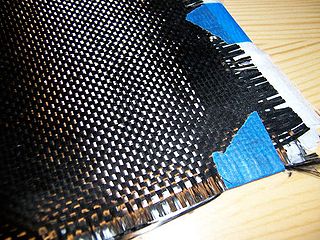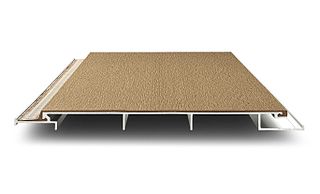
Fiber is a natural or artificial substance that is significantly longer than it is wide. Fibers are often used in the manufacture of other materials. The strongest engineering materials often incorporate fibers, for example carbon fiber and ultra-high-molecular-weight polyethylene.

Carbon fibers or carbon fibres are fibers about 5 to 10 micrometers (0.00020–0.00039 in) in diameter and composed mostly of carbon atoms. Carbon fibers have several advantages: high stiffness, high tensile strength, high strength to weight ratio, high chemical resistance, high-temperature tolerance, and low thermal expansion. These properties have made carbon fiber very popular in aerospace, civil engineering, military, motorsports, and other competition sports. However, they are relatively expensive compared to similar fibers, such as glass fiber, basalt fibers, or plastic fibers.

In materials science, a thermosetting polymer, often called a thermoset, is a polymer that is obtained by irreversibly hardening ("curing") a soft solid or viscous liquid prepolymer (resin). Curing is induced by heat or suitable radiation and may be promoted by high pressure or mixing with a catalyst. Heat is not necessarily applied externally, and is often generated by the reaction of the resin with a curing agent. Curing results in chemical reactions that create extensive cross-linking between polymer chains to produce an infusible and insoluble polymer network.

The mechanical structure of an aircraft is known as the airframe. This structure is typically considered to include the fuselage, undercarriage, empennage and wings, and excludes the propulsion system.

Lamination is the technique/process of manufacturing a material in multiple layers, so that the composite material achieves improved strength, stability, sound insulation, appearance, or other properties from the use of the differing materials, such as plastic. A laminate is a layered object or material assembled using heat, pressure, welding, or adhesives. Various coating machines, machine presses and calendering equipment are used.

Glare is a fiber metal laminate (FML) composed of several very thin layers of metal interspersed with layers of S-2 glass-fiber pre-preg, bonded together with a matrix such as epoxy. The uni-directional pre-preg layers may be aligned in different directions to suit predicted stress conditions.
Fibre-reinforced plastic is a composite material made of a polymer matrix reinforced with fibres. The fibres are usually glass, carbon, aramid, or basalt. Rarely, other fibres such as paper, wood, boron, or asbestos have been used. The polymer is usually an epoxy, vinyl ester, or polyester thermosetting plastic, though phenol formaldehyde resins are still in use.

Metallic fibers are manufactured fibers composed of metal, metallic alloys, plastic-coated metal, metal-coated plastic, or a core completely covered by metal.

1) In materials science, a sandwich-structured composite is a special class of composite materials that is fabricated by attaching two thin-but-stiff skins to a lightweight-but-thick core. The core material is normally of low strength, but its greater thickness provides the sandwich composite with high bending stiffness with overall low density.
Composite gear housing refers to the use of composite materials to enclose the components of motor transmissions. Fiber reinforced composite materials are used primarily for weight reduction. Carbon fiber reinforced plastic material is commonly used in the aerospace and automotive industries.

Honeycomb structures are natural or man-made structures that have the geometry of a honeycomb to allow the minimization of the amount of used material to reach minimal weight and minimal material cost. The geometry of honeycomb structures can vary widely but the common feature of all such structures is an array of hollow cells formed between thin vertical walls. The cells are often columnar and hexagonal in shape. A honeycomb-shaped structure provides a material with minimal density and relative high out-of-plane compression properties and out-of-plane shear properties.
Ceramic armor is armor used by armored vehicles and in personal armor to resist projectile penetration through its high hardness and compressive strength. In its most basic form, it consists of two primary components: A ceramic layer on the outer surface, called the "strike face," backed up by a ductile fiber reinforced plastic composite or metal layer. The role of the ceramic is to (1) fracture the projectile or deform the projectile nose upon impact, (2) erode and slow down the projectile remnant as it penetrates the shattered ceramic layer, and (3) distribute the impact load over a larger area, which can be absorbed by ductile polymer or metallic backings. Ceramics are often used where light weight is important, as they weigh less than metal alloys for a given degree of resistance. The most common materials are alumina, boron carbide, and, to a lesser extent, silicon carbide.
Carbon fiber-reinforced polymers, carbon-fibre-reinforced polymers, carbon-fiber-reinforced plastics, carbon-fiber reinforced-thermoplastic, also known as carbon fiber, carbon composite, or just carbon, are extremely strong and light fiber-reinforced plastics that contain carbon fibers. CFRPs can be expensive to produce, but are commonly used wherever high strength-to-weight ratio and stiffness (rigidity) are required, such as aerospace, superstructures of ships, automotive, civil engineering, sports equipment, and an increasing number of consumer and technical applications.
Three-dimensional composites use fiber preforms constructed from yarns or tows arranged into complex three-dimensional structures. These can be created from a 3D weaving process, a 3D knitting process, a 3D braiding process, or a 3D lay of short fibers. A resin is applied to the 3D preform to create the composite material. Three-dimensional composites are used in highly engineered and highly technical applications in order to achieve complex mechanical properties. Three-dimensional composites are engineered to react to stresses and strains in ways that are not possible with traditional composite materials composed of single direction tows, or 2D woven composites, sandwich composites or stacked laminate materials.

Tailored fiber placement (TFP) is a textile manufacturing technique based on the principle of sewing for a continuous placement of fibrous material for composite components. The fibrous material is fixed with an upper and lower stitching thread on a base material. Compared to other textile manufacturing processes fiber material can be placed near net-shape in curvilinear patterns upon a base material in order to create stress adapted composite parts.
Composite repairs are performed on damaged laminate structures, fibre reinforced composites and other composite materials. The bonded composite repair reduces stresses in the damaged region and prevents cracks from opening or growing. Composite materials are used in a wide range of applications in aerospace, marine, automotive, surface transport and sports equipment markets. Damage to composite components is not always visible to the naked eye and the extent of damage is best determined for structural components by suitable Non Destructive Test (NDT) methods.

Hybrid wood or wood hybrid systems (WHS) is a multilayer composite material, composed on the surface of a skin made of composite wood (WPC) adhering to an underneath structural core, in general aluminum. Invented in Japan in 2008, this technological evolution is based on wood composite technology which was conceived in 1972 by Sadao Nishibori and patented in 1983 to substitute threatened exotic wood species. WHS are not fibre-reinforced plastic (FRP).
Welding of advanced thermoplastic composites is a beneficial method of joining these materials compared to mechanical fastening and adhesive bonding. Mechanical fastening requires intense labor, and creates stress concentrations, while adhesive bonding requires extensive surface preparation, and long curing cycles. Welding these materials is a cost-effective method of joining concerning preparation and execution, and these materials retain their properties upon cooling, so no post processing is necessary. These materials are widely used in the aerospace industry to reduce weight of a part while keeping strength.
Adhesive bonding is a process by which two members of equal or dissimilar composition are joined. It is used in place of, or to complement other joining methods such mechanical fasting by the use nails, rivets, screws or bolts and many welding processes. The use of adhesives provides many advantages over welding and mechanical fastening in steel construction; however, many challenges still exist that have made the use of adhesives in structural steel components very limited.

In materials science, reinforcement is a constituent of a composite material which increases the composite's stiffness and tensile strength.











